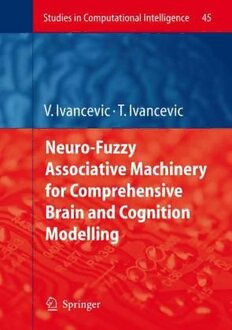
Neuro-Fuzzy Associative Machinery for Comprehensive Brain and Cognition Modelling PDF
Preview Neuro-Fuzzy Associative Machinery for Comprehensive Brain and Cognition Modelling
VladimirG.Ivancevic,TijanaT.Ivancevic Neuro-FuzzyAssociativeMachineryforComprehensive BrainandCognitionModelling StudiesinComputationalIntelligence,Volume45 Editor-in-chief Prof.JanuszKacprzyk SystemsResearchInstitute PolishAcademyofSciences ul.Newelska6 01-447Warsaw Poland E-mail:[email protected] Furthervolumesofthisseries Vol.36.IldarBatyrshin,JanuszKacprzyk,Leonid canbefoundonourhomepage: Sheremetor,LotfiA.Zadeh(Eds.) springer.com Preception-basedDataMiningandDecisionMaking inEconomicsandFinance,2006 Vol.27.VassilisG.Kaburlasos ISBN978-3-540-36244-9 TowardsaUnifiedModelingandKnowledge- RepresentationbasedonLatticeTheory,2006 Vol.37.JieLu,DaRuan,GuangquanZhang(Eds.) ISBN978-3-540-34169-7 E-ServiceIntelligence,2007 ISBN978-3-540-37015-4 Vol.28.BrahimChaib-draa,Jo¨rgP.Mu¨ller(Eds.) MultiagentbasedSupplyChain Vol.38.ArtLew,HolgerMauch Management,2006 DynamicProgramming,2007 ISBN978-3-540-33875-8 ISBN978-3-540-37013-0 Vol.39.GregoryLevitin(Ed.) Vol.29.SaiSumathi,S.N.Sivanandam ComputationalIntelligenceinReliability IntroductiontoDataMiningandits Engineering,2007 Application,2006 ISBN978-3-540-37367-4 ISBN978-3-540-34350-9 Vol.40.GregoryLevitin(Ed.) Vol.30.YukioOhsawa,ShusakuTsumoto(Eds.) ComputationalIntelligenceinReliability ChanceDiscoveriesinRealWorldDecisionMaking, Engineering,2007 2006 ISBN978-3-540-37371-1 ISBN978-3-540-34352-3 Vol.41.MukeshKhare,S.M.ShivaNagendra(Eds.) Vol.31.AjithAbraham,CrinaGrosan,Vitorino ArtificialNeuralNetworksinVehicularPollution Ramos(Eds.) Modelling,2007 StigmergicOptimization,2006 ISBN978-3-540-37417-6 ISBN978-3-540-34689-0 Vol.42.BerndJ.Kra¨mer,WolfgangA.Halang(Eds.) Vol.32.AkiraHirose ContributionstoUbiquitousComputing,2007 Complex-ValuedNeuralNetworks,2006 ISBN978-3-540-44909-6 ISBN978-3-540-33456-9 Vol.43.FabriceGuillet,HowardJ.Hamilton(Eds.) Vol.33.MartinPelikan,KumaraSastry,Erick QualityMeasuresinDataMining,2007 Cantu´-Paz(Eds.) ISBN978-3-540-44911-9 ScalableOptimizationviaProbabilistic Modeling,2006 Vol.44.NadiaNedjah,LuizadeMacedo ISBN978-3-540-34953-2 Mourelle,MarioNetoBorges,NivalNunes deAlmeida(Eds.) Vol.34.AjithAbraham,CrinaGrosan,Vitorino IntelligentEducationalMachines,2007 Ramos(Eds.) ISBN978-3-540-44920-1 SwarmIntelligenceinDataMining,2006 ISBN978-3-540-34955-6 Vol.45.VladimirG.Ivancevic,TijanaT.Ivancevic Neuro-FuzzyAssociativeMachineryfor Vol.35.KeChen,LipoWang(Eds.) ComprehensiveBrainandCognitionModelling, TrendsinNeuralComputation,2007 2007 ISBN978-3-540-36121-3 ISBN978-3-540-47463-0 Vladimir G. Ivancevic Tijana T. Ivancevic Neuro-Fuzzy Associative Machinery for Comprehensive Brain and Cognition Modelling With 123 Figures and 4 Tables 123 Dr.VladimirG.Ivancevic HumanSystemsIntegration LandOperationsDivisionDefence Science&TechnologyOrganisation POBox1500 75Labs EdinburghSA5111,Australia E-mail:[email protected] TijanaT.Ivancevic TheUniversityofAdelaide DepartmentofAppliedMathematics SchoolofMathematicalSciences SA5005,Australia E-mail:[email protected] LibraryofCongressControlNumber:2006935539 ISSNprintedition:1860-949X ISSNelectronicedition:1860-9503 ISBN-10 3-540-47463-3SpringerBerlinHeidelbergNewYork ISBN-13 978-3-540-47463-0SpringerBerlinHeidelbergNewYork Thisworkissubjecttocopyright.Allrightsarereserved,whetherthewholeorpartofthematerial isconcerned,specificallytherightsoftranslation,reprinting,reuseofillustrations,recitation,broad- casting,reproductiononmicrofilmorinanyotherway,andstorageindatabanks.Duplicationof thispublicationorpartsthereofispermittedonlyundertheprovisionsoftheGermanCopyrightLaw ofSeptember9,1965,initscurrentversion,andpermissionforusemustalwaysbeobtainedfrom Springer-Verlag.ViolationsareliabletoprosecutionundertheGermanCopyrightLaw. SpringerisapartofSpringerScience+BusinessMedia springer.com (cid:1)c Springer-VerlagBerlinHeidelberg2007 Theuseofgeneraldescriptivenames,registerednames,trademarks,etc.inthispublicationdoesnot imply, even in the absence of a specific statement, that such names are exempt from the relevant protectivelawsandregulationsandthereforefreeforgeneraluse. Coverdesign:deblik,Berlin TypesettingbytheauthorsandSPi Printedonacid-freepaperSPIN:11898467 89/SPi 543210 Preface Neuro–Fuzzy Associative Machinery for Comprehensive Brain and Cognition Modeling is a graduate–level monographic textbook. It represents a compre- hensive introduction into both conceptual and rigorous brain and cognition modeling.Itisdevotedtounderstanding,predictionandcontrolofthefunda- mental mechanisms of brain functioning. The objective of the monograph is to provide a reader with a scientific tool that will enable him/her to actually perform a competitive research in brain and cognition modeling. This book has four Chapters and Appendix. The first Chapter gives an introduction into brain anatomy, physiology and biophysics, as well as psy- chology and engineering of cognition. It also introduces the functorial meta- language, which is essential for global comprehension of brain and cognition. The second Chapter reviews various approaches (or, functors) currently used forbrainandcognitionmodeling,including:(i)nonlineardynamicsandchaos, (ii) control and complex systems and networks, (iii) intelligent (BDI) agents, (iv) neural networks, (v) cellular automata and genetic algorithms, (vi) fuzzy logic, and (vii) synergetics. The third Chapter develops the neurodynamics, neuro–synergetics and synchronization approach of brain and cognition mod- eling. The fourth Chapter further develops fuzzy and neuro–fuzzy systems. It alsogivesourneuro–fuzzymodelingapproachtoreal–lifegames.TheAppen- dixhastwosections:(i)universallanguageofcategoriesandfunctors,and(ii) glossary of frequent neurophysiological terms. Target readership includes all researchers and students interested in brain and cognition modeling (in computer science, engineering, mathematics, physics, chemistry, biology, psychology, sociology, economics, medicine, etc.), working both in industry (i.e., clinics) and academia. Adelaide, V. Ivancevic, Defence Science & Technology Organisation, Aug 2006 Australia, e-mail: [email protected] T. Ivancevic, School of Mathematics, The University of Adelaide, e-mail: [email protected] Dedicated to Nitya, Atma and Kali Acknowledgments The authors wish to thank Land Operations Division, Defence Science & TechnologyOrganisation,Australia,forthesupportindevelopingtheHuman Biodynamics Engine (HBE)andalltheHBE–relatedtextinthismonograph. We also express our gratitude to Springer book series Studies in Compu- tational Intelligence andespeciallytotheEditor,ProfessorJanuszKacprzyk. Contents 0.1 Glossary of Frequently Used Symbols ...................... 1 1 Introduction to Brain and Cognition....................... 3 1.1 Brain .................................................. 3 1.1.1 Basics of Brain Physiology.......................... 10 1.1.2 Modern 3D Brain Imaging.......................... 30 1.2 Cognition and Associative Memory ........................ 37 1.3 Categorical Language for Neuro–Cognition.................. 43 1.3.1 Categorical Patterns and Hierarchical Links .......... 44 1.3.2 A General Natural System.......................... 46 1.3.3 The Category of Neurons........................... 47 1.3.4 Memory Evolutive System.......................... 47 1.3.5 Neural System in a Category ....................... 49 1.4 Hierarchical Associative Machinery of n−Functors ........... 51 1.4.1 Preliminary Examples of Brain and Cognition Functors ......................................... 56 2 Various Approaches (Functors) to Brain and Cognition Modeling .................................................. 61 2.1 Nonlinear Dynamics and Chaos Approach .................. 61 2.1.1 Chaos Theory Basics .............................. 62 2.1.2 Chaos Control .................................... 81 2.1.3 Fractal Calculus and Chaos Control .................103 2.1.4 Josephson Junctions and Quantum Computing........106 2.1.5 Solitons ..........................................110 2.1.6 Chaos Field Theory................................116 2.1.7 Geometrical Nonlinear Dynamics ....................118 2.1.8 Dynamics of n−Functors ...........................120 2.2 Systems and Networks Approach ..........................122 2.2.1 MIMO Systems and Kalman Filtering................122 2.2.2 Nonlinear Control Systems .........................128 2.2.3 Complex Adaptive Systems.........................144 X Contents 2.2.4 Complex Networks and Synchronization Dynamics.....147 2.2.5 Small–Worlds and Social Networks ..................152 2.3 Intelligent (BDI) Agents Approach ........................155 2.3.1 Agents Environments ..............................161 2.3.2 Agents’ Reasoning and Learning ....................164 2.4 Neural–Networks Approach ...............................183 2.4.1 Biological Versus Artificial Neural Nets ..............184 2.4.2 Common Discrete ANNs ...........................185 2.4.3 Common Continuous ANNs ........................209 2.4.4 Support Vector Machines...........................217 2.4.5 Dynamical Nets for Thought Process Modeling........220 2.5 Cellular and Evolutionary Approach .......................228 2.5.1 Cellular Automata.................................229 2.5.2 Evolutionary Algorithms ...........................237 2.6 Fuzzy–Logic Approach ...................................246 2.6.1 The Concept of Fuzziness ..........................246 2.6.2 Fuzzy Inference Engine.............................255 2.6.3 Fuzzy Logic Control ...............................258 2.7 Synergetics Approach ....................................267 2.7.1 Phase Transitions .................................270 2.7.2 Hamiltonian Biodynamics ..........................271 2.7.3 Kick Dynamics and Dissipation–Fluctuation Theorem .........................................273 2.7.4 Mezoscopic Derivation of Order Parameters...........276 2.7.5 Example: Synergetic Control of Biodynamics..........278 2.7.6 Example: Chaotic Psychodynamics of Perception ......280 3 Neuro–Dynamics, Synergetics and Synchronization ........285 3.1 Distinguished ANN Models ...............................285 3.1.1 Generalized Kohonen’s SOM........................285 3.1.2 Dynamics of Hopfield’s Associative Recurrent Nets ....289 3.1.3 A Self–Organizing Bidirectional Competitive Net ......296 3.1.4 Vector AM–Neural Nets............................297 3.1.5 Small–World AM–Neural Nets ......................307 3.2 Local Neurodynamics ....................................311 3.2.1 Microscopic Neurodynamics and Quantum Brain ......311 3.2.2 Macroscopic Neurodynamics ........................324 3.2.3 Darwinian Oscillatory Neural Net ...................345 3.2.4 Oscillatory Phase Synchronization in Neurodynamics .................................347 3.2.5 Synchronization in Cellular Automata ...............355 3.2.6 Kuramoto–Type Dynamics of Complex Nets ..........360 3.2.7 Oscillator AM with Scattered Natural Frequencies.....363 3.2.8 AM Neural Nets with Self–Control ..................367 3.2.9 BAM and Statistical Neurodynamics.................375 3.2.10 Firing Correlation in Layered AM Neural Nets ........384 3.3 Synergetics of Recurrent and Attractor Neural Nets..........388
